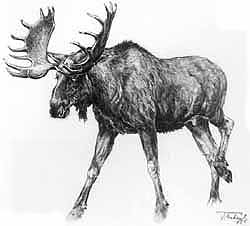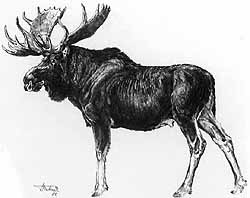English: Moose or Elk; French: Elan; Algonquin: Mos; Chinese: To-lu; Chipewyan: deniye; Cree: mooswa; Dogrip: dendi; Finnish: Hirvi; Lettish: Poder; Lithuanian: Briedis; Loucheux: dinjik; Mongol: Khandgai; Norwegian: Elg; Polish: Tos; Russian: Woss; South-Slavey: golo, dendi; Swedish: Älg.
 |
| Alces a. alces |
Former distribution: All over the humid forests of the Holarctic.
Present distribution: Northern Europe, from Norway, Sweden, Finland east to the European USSR to Siberia, northern Mongolia and northern Heilong-jiang (Manchuria) in China; Canada, Alaska. USA.
Behaviour: Preferred habitat: marshy forest regions, taigas, close to water and swamps, where they browse waterplants, roots, bark of trees and twigs of willow and poplar. Moose are essentially solitary, but they may live in small family groups of 2 or 3. They are good swimmers, and migrate from their summer to their winter feeding areas. Predators include wolves, bears.
Population status: Stable; increasing in Scandinavia, stable in USSR, and North America; rare in Mongolia and Heilongjiang (Manchuria).
Brief notes:
Body weight: 500-800 kg
Head and body length: 250-350 cm
Tail length: 7-10 cm
Shoulder height: 160-230cm
Gestation period: 242-250 days
Maximum age: About 20 years
Trophy: Record SCI: Western Canada Moose (Alces a. andersoni) 264 4/7 score, 1980 British Columbia, MICHAEL LAUB; average 160 score. Eastern Canada Moose (Alces a. americana) 220 5/8 score, 1975 Ontario, RON PORTER; average 140 score. Alaska-Yukon Moose (Alces a. gigas) 287 5/8 score, 1981 Yukon, MELVIN R. SPOHN; average 200 score. Shiras Moose (Alces a shirasi) 192 2/8 score, 1968 Wyoming, DAVE TITE; average 130 score. B&C: Canada Moose (Alces a. andersoni) 238 5/8 score, 1914 Bear Lake, SILAS H. WITHERBEE; average 195 score. Alaska-Yukon Moose (Alces a. gigas) 251 score, 1961 Alaska, BERT KLINEBURGER; average 224 score. Shiras Moose (Alces a. shirasi) 204 4/8 score, Wyoming, JOHN O. OAKLEY; average 155 score. RW’s: Alces alces: 217 1/4 points, 1972 Yakutia, USSR, n.n.; average 180 points. CIC: Alces a. alces: 420.2 points, 1982 Sweden, LEIF JACOBSSON; 392.7 points, 1982 Finland, VEIKKO SIPILÄ; 353.0 points, 1960 Norway, HENRY GAUNDAL, HANS BRANDSÖ; 354.92 points, 1971 Mongolia, n.n. Alces a. pfizenmayeri: 470.29 points, 1972 USSR, Yucatian Hunting Ass.; average 350 points.
Hunting methods: Stalking, with „loose“ dogs, with beaters, on horseback.
Subspecies: 8
1. Alces a. alces Scandinavia, Finland, Poland, east to the Jenissei. Stable. Estimated numbers: USSR: 700 000; Scandinavia: 500 000-700 000; Poland: 4000-5000.
2. Alces a. pfizenmayeri USSR from Jenissei east through Siberia, south to the Stanovoy Mountains. Stable. Estimated numbers: No records.
3. Alces a. buturlini USSR, eastern Siberia (Indigirka to Anadyr basis). Stable.
4. Alces a. cameloides USSR: Amur-Ussuri region; northern Mongolia, northern Heilongjiang (Manchuria) in China, north to the Stanovoy Mountains. Stable. Estimated numbers: 11 000 acc. to KRUPKA (1984).
5. Alces a. gigas Alaska, western Yukon in Canada, and northern British Columbia. Stable. Estimated numbers: 150 000.
6. Alces a. andersoni Central British Columbia east to northern Minnesota and western Ontario. Stable. Estimated numbers: 350 000.
7. Alces a. shirasi From southern Alberta in Canada south to Idaho, Montana and Wyoming. Stable. Estimated numbers: 25 000.
8. Alces a. americana From central Ontario east to Maine and Newfoundland. Stable. Estimated numbers: 250 000.
Subspecies Nr. 9, the Caucasian Moose, Alces a. caucasicus, became extinct about 1900. It was a small moose similar to A.a. cameloides. Domestication trials on moose were started (1937) in USSR with Alces a. alces; they are still continuing with good results.
Remarks: In the southern distribution areas of Scandinavia the non-palmated horns are dominant, up north they become more palmated. The same construction is present in Alces a. cameloides from the Amur-Ussuri and Mongolia. The biggest moose in body and trophy are recorded in Alaska and neighbouring Siberia (A.a. gigas and A.a. pfizenmayeri). In Europe, western USSR and USA they are medium sized (A.a. alces, A.a. shirasi). Moose meat is of great importance to the Scandinavian countries, and also for the native populations of North America and USSR.
|









